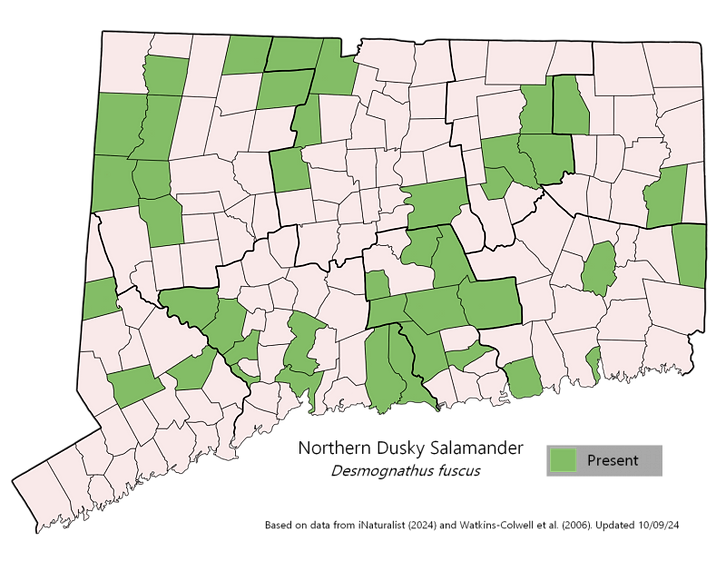Northern dusky salamander
Desmognathus fuscus
Conservation Status:
State Status: Apparently Secure (NatureServe, 2025)
Global Assessment: Least Concern (IUCN, 2021)
Description
Northern dusky salamanders grow up to five inches long (Watkins-Colwell, 2025). They can be varying shades of brown, sometimes with darker mottling or a lighter stripe down the back. They have a laterally flattened tail.
Habitat
This species can be found around shallow bodies of water, most commonly streams or rivers. They may also be found in areas near springs with moist soil.
Behavior
Dusky salamanders spend a majority of their time hiding, whether it be in burrows or under debris on the forest floor. These hiding places are generally located within the vicinity of a stream or other body of water. This species eats small invertebrates.
Breeding occurs in the spring or fall, and eggs are laid in the summer under debris near water. These hatch into aquatic larvae. Predators of this species include small mammals, birds, and snakes.
Range

References
iNaturalist. (2024). Observations. California Academy of the Sciences / National Geographic Society. https://www.inaturalist.org/observations?place_id=49&taxon_id=27420.
International Union for Conservation Of Nature and Natural Resources. (2021, July 1). Dusky Salamander. https://www.iucnredlist.org/species/78904880/58035807.
NatureServe. (2025, January 31). Desmognathus fuscus. https://explorer.natureserve.org/Taxon/ELEMENT_GLOBAL.2.859647/Desmognathus_fuscus.
Watkins-Colwell, G. J. (2025). Northern Dusky Salamander - Desmognathus fuscus. Yale Peabody Museum. https://peabody.yale.edu/explore/collections/herpetology/guide-amphibians-reptiles-connecticut.
Watkins-Colwell, G. J. et al. (2006). New Distribution Records for Amphibians and Reptiles in Connecticut, with Notes on the Status of an Introduced Species. Sacred Heart University. https://digitalcommons.sacredheart.edu/cgi/viewcontent.cgi?article=1058&context=bio_fac.
Page updated March 2, 2025
